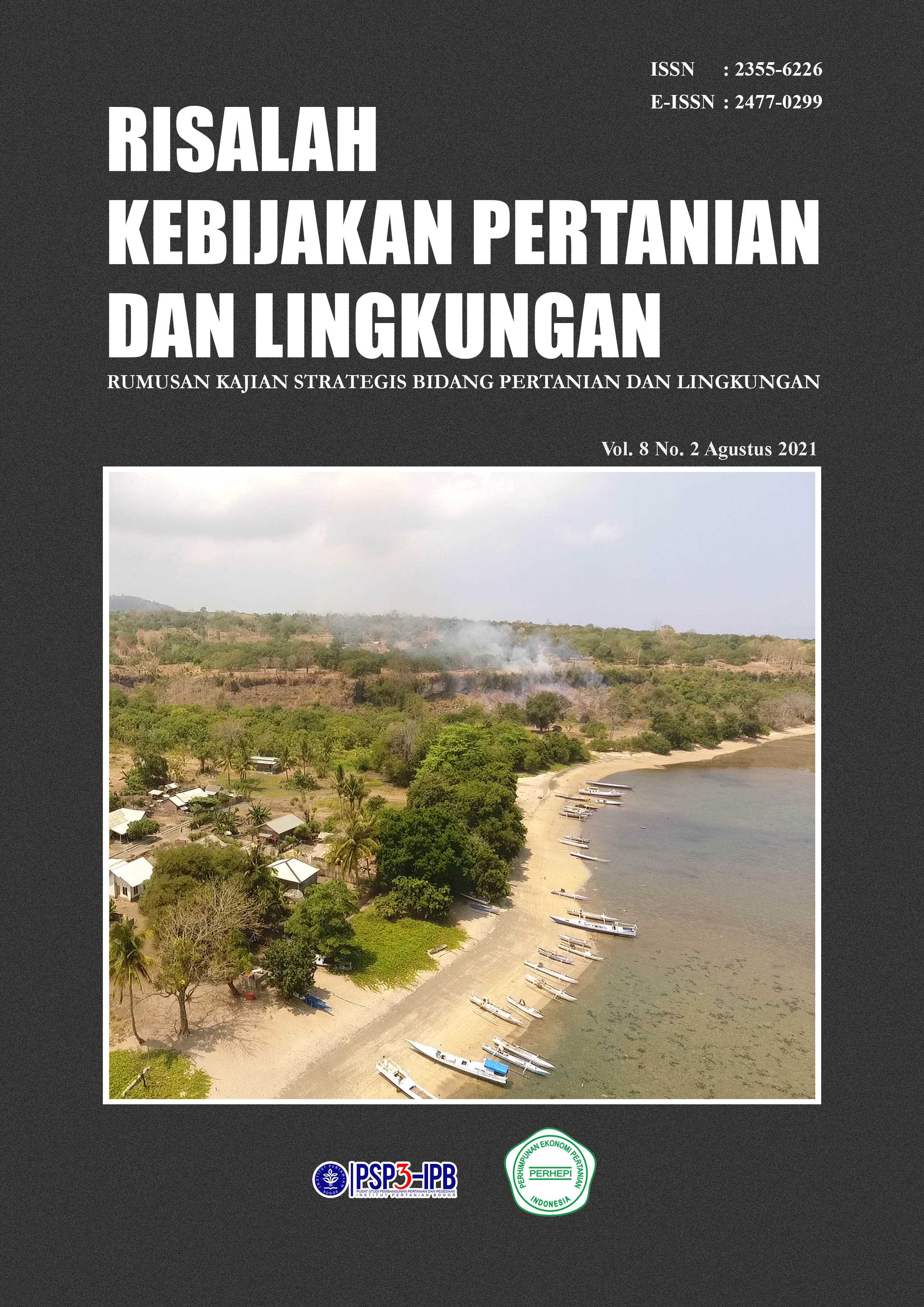ANALISIS RAPFISH DALAM PENYUSUNAN KEBIJAKAN PENGELOLAAN PENANGKAPAN GLASS EEL (Anguilla spp.) DI MUARA SUNGAI CIMANDIRI, JAWA BARAT
Abstract
Penelitian untuk menyusun kebijakan pengelolaan penangkapan glass eel ikan sidat dilakukan dengan menerapkan analisis RAPFISH. Penelitian dilakukan pada Desember 2017-November 2018 di Sungai Cimandiri Jawa Barat. Analisis RAPFISH untuk menilai status keberlanjutan penangkapan glass eel dilakukan pada lima dimensi keberlanjutan, yaitu dimensi ekologi, teknologi, ekonomi, sosial dan kelembagaan. Status keberlanjutan penangkapan glass eel adalah cukup berlanjut. Dimensi teknologi berada pada kondisi sangat berlanjut, dimensi ekologi, sosial dan kelembagaan cukup berlanjut dan dimensi ekonomi kurang berlanjut. Kebijakan pengelolaan penangkapan glass eel ditentukan dari keberlanjutan dimensi ekologi, dimana hasil tangkapan glass eel telah mengalami penurunan yang signifikan. Pengaturan upaya tangkap dan pembatasan jumlah tangkapan glass eel yang sesuai dengan kemampuan lestarinya perlu dijadikan sebagai regulasi kebijakan dalam mengelola sumberdaya tersebut.
Metrics
Downloads
References
Alder, J., Pitcher T.J., Preikshot, D, Kaschner, K, Ferris B. 2000. How Good is Good? A Rapid Appraisal Technique for Evaluation of the Sustainability Status of Fisheries of The North Atlantic. In Pauly and Pitcher (eds). Methods for Evaluation the Impact of Fisheries on North Atlantic Ecosystem. Fisheries Center Research Reports. (8) No 2.
Aprahamian, M., Walker, A. 2008. Status of eel fisheries, stoks and their management in England and Wales. Knowl. Managt. Aquatic Ecosyst. (07): 390-391.
Adrianto, L. 2015 Pengelolaan Perikanan dengan Pendekatan Ekosistem Integrasi Platform Pengelolaan Kawasan Konservasi Perairan dan Perikanan dalam Tata Kelola Kawasan Konservasi Perairan untuk Perikanan Berkelanjutan di Indonesia (Ed) Luky Adrianto. Publikasi PKSPL-IPB No 1/Tahun 2015.
American Public Health Association: APHA. 2017. Standard Methods for The Examination of Water and Waste Water. (17thed.). Washington DC, USA:APHA. 1193 pp.
Fauzi, A., Anna, S. 2002. Penilaian Depresiasi Sumberdaya Perikanan Sebagai Bahan Pertimbangan Penentuan Kebijakan Pembangunan Perikanan. Jurnal Pesisir dan Lautan. 4 (2): 36-49.
Fauzi, A., Anna, S. 2005. Permodelan Sumber Daya Perikanan dan Kelautan. Jakarta (ID): PT. Gramedia Pustaka Utama.
Hartono, T.T., Kodiran, T, Iqbal, Koeshendrajana, S. 2005. Pengembangan teknik Rapid Appraisal for Fisheries (RAPFISH) untuk penentuan indikator kinerja perikanan tangkap berkelanjutan di Indonesia. Buletin Ekonomi Perikanan. 4 (1): 65-76.
Hakim, A.A., Kamal, M.M., Butet, N.A., Affandi, R. 2015. Komposisi Spesies Ikan Sidat (Anguilla spp.) di Delapan Sungai yang Bermuara ke Teluk Palabuhanratu, Sukabumi, Indonesia. Jurnal Ilmu dan Teknologi Kelautan Tropis. 7 (2): 573-586.
Haryono, Wahyudewantoro, G. 2016. Pemetaan habitat ruaya benih ikan sidat (Anguilla bicolor) dan potensinya di pantai Selatan Jawa. Omni-Akuatika. 12 (3): 47-58.
Jacoby, D.M.P., Casselman, J.M., Crook, V, DeLucia, M.B., Ahnf, H, Kaifu, K, Kurwieh, T, Sasal, P, Silfvergrip A.M.J., Smithk, K.G., Uchida, K., Walker, A.M., Gollock, M.J. 2015. Synergistic Patterns Of Threat And The Challenges Facing Global Anguillid Eel Conservation. Global Ecology and Conservation. 4: 321–333.
Kavanagh, P., Pitcher T.J. 2004. Implementing microsoft excel software for Rapfish: A technique for the Rapid Appraisal of Fisheries Status. Fisheries Centre Research Reports. 12(2): 75pp.
Lokman, P.M., Wylie, M.J., Downws, M., Biase, A.D., Damsteegt, E.L. 2014. Artificial induction of maturation in female silver eels, Anguilla australis: The benefits of androgen pre-treatment. Aquaculture. 437: 111–119.
Nababan, B.O., Sari, Y.D., Hermawan, M. 2007. Analisis Keberlanjutan Perikanan Tangkap Skala Kecil di Kabupaten Tegal Jawa Tengah (Teknik Pendekatan RAPFISH). J.Bijak dan Riset Sosek KP. 2 (2): 137-158.
Rousseau, K., Lafont, A.G., Pasquier, J., Maugars, G, Joly, C, Sebert, M.E., Aroua, S, Pasqualini, C, Dufour, S. 2014. Advances in eel reproductive physiology and endocrinology. Di dalam : Trischitta F, Takei Y, Sebert P, editor. Eel Physiology. Boca Raton (US): CRC Press. Taylor & Francis Group. pp 1-43.
Sriati. 1998. Telaah Struktur dan Kelimpahan Populasi Benih Ikan Sidat, Anguilla bicolor bicolor, di Muara Sungai Cimandiri, Pelabuhan Ratu, Jawa Barat. Tesis Program Pascasarjana, Institut Pertanian Bogor: Bogor.
Susilo. 2003. Keberlanjutan Pembangunan Pulau-pulau Kecil: Studi Kasus Kelurahan Pulau Panggang dan Pulau Pari, Kepulauan Seribu, DKI Jakarta. Disertasi. Sekolah Pascasarjana Institut Pertanian Bogor: Bogor.
Susanto, A., Rusdianto, E., Sumartono. 2016. Strategi kebijakan pengelolaan situ berkelanjutan: Studi kasus situ kedaung, kecamatan pamulang, Kota Tanggerang Selatan. LIMNOTEK. 23 (2) : 50-60.
Tesch, F.W. 2003. The Eel. Third edition. Thorpe JE, editor. Oxford (UK): Blackwell Publishing Ltd. 408 p.
Widyasari, H. 2013. Disain Terpadu Pengembangan Industri Perikanan Sidat Indonesia (Anguilla Spp) Berkelanjutan di Palabuhanratu Kabupaten Sukabumi Provinsi Jawa Barat. Disertasi. Sekolah Pascasarjana Institut Pertanian Bogor: Bogor.
Copyright (c) 2021 RISALAH KEBIJAKAN PERTANIAN DAN LINGKUNGAN: Rumusan Kajian Strategis Bidang Pertanian dan Lingkungan

This work is licensed under a Creative Commons Attribution 4.0 International License.
PUBLICATION ETHICS
Jurnal Risalah Kebijakan Pembangunan Pertanian dan Lingkungan (JRKPL) is a peer-reviewed journal publishing original research to develop a coherent and respected network of landscape architecture knowledge. JRKPL committed to upholding the highest standards of publication ethics that clarifies ethical behavior of all parties involved in publishing a scientific article in JRKPL.
As publisher of JRKPL, PSP3-LPPM IPB and PERHEPI takes its duties of guardianship all stages of publishing process and we recognize our ethical and other responsibilities.
Duties of Authors
An author should not publish manuscripts describing essentially the same research in more than one journal or primary publication. Submitting the same manuscript to more than one journal is unacceptable and constitutes unethical publishing behavior. In general, an author should not submit for consideration in another journal a previously published paper.
Authorship should be limited to those who have made a significant contribution to the manuscript and should be listed as co-authors. Where there are others who have participated in certain substantive aspects of the research project, they should be acknowledged as contributors. The corresponding author should ensure that all co-authors have seen and approved the final version of the paper and have agreed to its submission for publication.
The authors should ensure that they have written entirely original works, and if the authors have used the work and/or words of others, that this has been appropriately cited or quoted. Plagiarism are include passing off another paper as the author own paper, copying or paraphrasing substantial parts of another paper (without attribution) and claiming results from research conducted by others. Plagiarism constitutes unethical publishing behavior and is unacceptable. Plagiarism detected works will be banned for further publication procedure.
The authors acknowledge that they have disclosed all and any actual or potential conflicts of interest with their work or partial benefits associated with it. All sources of financial support for the project should be disclosed. Potential conflicts of interest should be disclosed at the earliest stage possible.
Duties of the Editorial Board
Review Process
JRKPL is committed to objective and fair double-blind peer-review to prevent any actual or potential conflict of interests between the editorial and review personnel and the reviewed material. JRKPL chooses reviewers based on their expertise (whose most closely matches the topic of the paper). At least 2 reviewers are invited to evaluate a manuscript. In cases of controversy or disagreement regarding the merits of the work, an additional review will be solicited. The JRKPL editor mediates all interaction between authors and reviewers, and the review results owned by JRKPL.
Publication Decisions
The editor of a peer-reviewed JRKPL is responsible for deciding which of the articles submitted to the journal should be published. The validation of the work in question and its importance to researchers and readers must always drive such decisions. The final decision on article acceptance based on reviewer's opinions, suggestions, and comments. The editor may confer with other editors or reviewers in making this decision.
Fair Play
JRKPL evaluates manuscripts only based on the intellectual content. No race, gender, sexual orientation, religious belief, ethnic origin, citizenship, or political philosophies of the authors are considered in the evaluation process.
Confidentiality
JRKPL assure the confidentially of the manuscripts, actors, and other related information on the publishing process. Only corresponding author, reviewers, potential reviewers, other editorial advisers, and the publisher are allows for the information.
Disclosure
Unpublished materials disclosed in a submitted manuscript must not be used in an editor's own research without the express written consent of the author. Privileged information or ideas obtained through peer review must be kept confidential and not used for personal advantage.
Duties of reviewers
(1) Objectivity: Reviewer should provide written and unbiased feedback to the authors, personal criticism of the author is inappropriate. Reviewer comments should be clearly with supporting arguments indicating whether the writing is concise and relevant
(2) Expertise: Reviewer who feels unqualified to review the research reported in a manuscript or knows that its prompt review will be impossible should notify the editor and excuse himself from the review process.
(3) Acknowledgement of sources: Reviewer suggest relevant published work that has not been cited by the authors to improve the quality of the manuscript,
(4) Confidentiality: Reviewer should maintain the confidentiality of the review process. Privileged information or ideas obtained through peer review must be kept confidential and not used for personal advantage.
(5) Disclosure and conflict of interest: Unpublished materials disclosed in a submitted manuscript must not be used in a reviewer own research without the express written consent of the author. Reviewers should not consider manuscripts in which they have conflicts of interest resulting from competitive, collaborative, or other relationships or connections with any of the authors, companies, or institutions connected to the papers.























